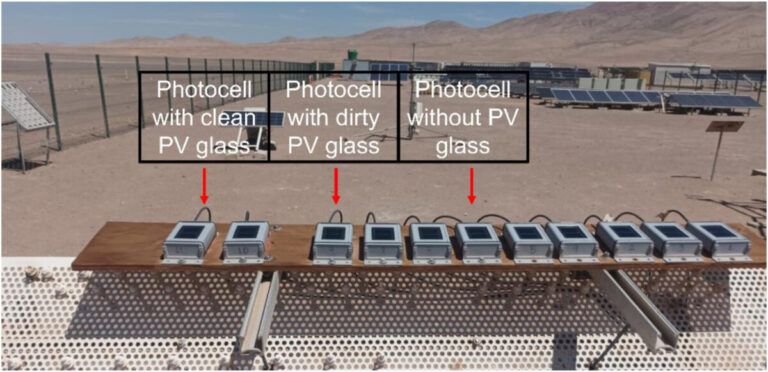An international research team studied the solar PV impact of emissions from a coal-fired power station in the Atacama desert, and noted that after five months of exposure the deposited substance on co-allowed PV panels achieved a maximum of 1.63 mg/cm2 with a 23 % reduction in the photocurrent. The accumulation in the co-located plant was 3 times larger than nearby PV locations with similar coastal climate conditions.
Aware of the operational and maintenance costs (R&M) costs to combat the PV panel in arid and heavily industrialized areas, a group of researchers from Chile and Spain investigated the impact of the emissions of a thermoelectric coal plant on solar panels on three locations in the Kolening -Installation -Woest wax.
The dust adhesion mechanisms, composition and effects on optical transmission and power density reduction were studied, whereby the scientists also briefly discuss specific cleaning and maintenance strategies to maintain system performance at PV plants in the vicinity of coal-fired thermoelectric stations.
“We have noticed that a growing trend of solar panels was lured together with industrial facilities. That raised questions about how emissions and by-products of these industries influence the fast of nearby PV systems compared to standard reference sites,” Aitor Marzo said co-spinning author of the study. PV Magazine.
“Moreover, a PV operator contacted us at different km away about unexpected pollution rates,” said Douglas Olivares, co-correcting author of the investigation, adding that the observations of the operator differed from what was initially expected, which encouraged a deeper investigation.
“We have focused on how residues of the flue gas dealing process can create a coal-fired power plant that can create unusually stubborn dust crusts on PV modules,” Marzo explained further. “By combining chemical analyzes with performance tests, we have shown exactly how these by -products are on the panel surfaces cement.”
The test setup was located in Mejillones, a city known for organizing the largest concentration of coal -fired power plants in Chile, according to the research. The academics evaluated the transmission losing a 21.6 kW of solar PV factory that was located on the spot on a coal-fired generation station, and they investigated the dust accumulation on the surface of the panels for a period of 5 months, weekly from September 21, 2022 to March 2, 2023.
The PV glass samples were without anti-tost coatings and were installed with a northern orientation and a lift of 20 degrees. The results of the radiation sensor were compared with a monster with clean glass. The impact of the coal-fired power station on the Co-located modules showed that after five months of exposure the deposited substance reached a maximum of 1.63 mg/cm2, with a pollution speed up to six times higher compared to other locations studied, resulting in a 23 % reduction in the photocurrent, the team said.
The results obtained were compared with three other locations in the Atacama desert. “Moreover, our results indicate that the effects of the activity of the power plant are noticeable up to 9 km away, especially clearly in areas with high humidity, where the solubility of materials improved the recrystallization and consolidation of fabric on module surfaces,” the researchers added.
“We were surprised by the reach of this desulfurization by-products. They facilitated Cementation on Modules, even a few kilometers away from the plant-Like that we had not expected to see at that distance,” said Olivares, and noted that calcite was used in sulfur gas reduction processes in the power plant) on the Synthetical Synnthebulation generated on the Synnthetallatie Op optallatatie Op optallatie Op optallatie Op optallatatie Op optallatatie Op optallatatie Op Opbulatie Op Op Ont SynntheTallatie Op Op the Folding Filation) Op the Synnthetallaties) Op Synnethetallation) used.
The team noted that the study only investigated optical transmission and power density results. Other measurements, such as the ability and the long-term relegation effects, are awaiting further research.
The research work was described in “Impact of the emissions of thermo-electric coal-fired power plants on the pollution mechanisms of nearby photovoltaic power plants in the Atacama desert‘Recently published by Renewable energy. The scientists came from the Chili-based Universidad de Antopagasta, Universidad de Chile, Universidad Técnica Federico Santa Maria and the Millenium core in Nanobiophysics (NNBP), as well as Spain’s Universid de Granada, University of Almeriaand Loyola University Andalusia.
Since completing the study, the study has drawn “considerable interest” from PV factory operators, especially in the Atacama desert. “Various companies have searched for our findings to understand how local factors intensify. They have since used these insights to optimize cleaning schedules and maintenance strategies,” said Olivares.
To the question of future research directions, Marzo replied: “We intend to extend our work to broader industrial contexts, to refine oming methods and develop localized pollution cards to support PV design and maintenance in hard environments.” Other research collaborations with teams in Europe, Spain and Chile are also underway.
This content is protected by copyright and may not be reused. If you want to work with us and reuse part of our content, please contact: editors@pv-magazine.com.


